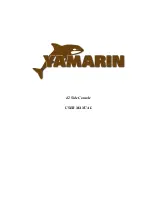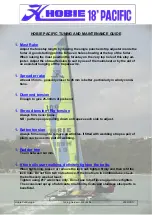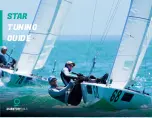
Chaparral Boats recommends using alcohol-free gasoline when
possible because alcohol tends to destroy marine fuel system hoses
and other components. If only gasoline containing alcohol is avail-
able or if you do not know whether the gasoline contains alcohol,
inspect the fuel system for leaks and abnormalities more frequently.
Preliminary Procedures
1. Safely and securely moor your boat to the dock.
2. Turn off engine and all electrical equipment including lights,
bilge pump, bilge blower, etc.
3. Extinguish all cigarettes, cigars, pipes, or other items that may
produce a spark or flame.
4. Close all hatches, windows, doors, and compartments.
5. Make sure a fire extinguisher is readily available.
Fueling Procedures
1. Always fuel in an area which has sufficient lighting. Gasoline
spills are hard to see when lighting is poor or it is dark.
Important: When fueling or having someone else fuel your
boat, be sure the waste or water fill caps are not mistaken for
the fuel fill cap. Also, make sure a fishing rod holder is not mis-
taken for a fuel fill plate.
2. Your Chaparral boat has fittings for filling the fuel tank on each
side of the boat, where applicable. Remove fuel fill plate. Insert
the fuel supply nozzle. Allow nozzle to stay in contact with fitting
to prevent possible static-produced sparks.
Note: The fuel fill cap has a built in tank ventilation feature. If
you should need to replace the cap, see your dealer for the
exact same cap to ensure proper fuel system operation.
3. After pumping approximately 5 gallons of fuel into tank, inspect
engine and fuel tank area for any signs of fuel leakage. Continue
fueling if you do not detect any leaks or other problems.
4. Allow space at the top of the tank for thermal expansion. Do not
overfill tank so that fuel comes out fuel tank vent.
Note: Do not over fill tank, causing fuel to spill onto water.
5. If fuel can not be pumped in at a reasonable rate, check for a
plugged fuel vent plug or kink in the line.
Post-Fueling Procedures
1. When you have finished fueling, replace fuel fill cap and wash
off any fuel spillage around fuel fill area. Discard, in a safe place,
any rags you may have used to wipe off fuel spills.
5-7
DANGER:
Fuel vapors are explosive and can become trapped
within the lower portions of the boat. Close all hatches, win-
dows, doors, and compartments while fueling your boat.
WARNING
AVOID DAMAGE TO YOUR FUEL SYSTEM
DO NOT USE FUEL OR ADDITIVES CONTAINING MORE
THAN 10% ALCOHOL BY VOLUME (Methanol or Ethanol)
DAMAGE AND LOSS OF WARRANTY MAY RESULT
Summary of Contents for SSI 180
Page 2: ......
Page 4: ......
Page 12: ...vi...
Page 19: ...1 7...
Page 20: ......
Page 24: ......
Page 26: ......
Page 42: ...2 16...
Page 62: ...3 20...
Page 92: ...5 16...
Page 110: ......
Page 118: ......
Page 124: ......
Page 125: ...WIRING SCHEMATICS 12 12 1 180 SSI...
Page 126: ...12 2 180 SSI...
Page 127: ...12 3 196 206 216 SSI...
Page 128: ...12 4 196 206 216 SSI...
Page 129: ...12 5 204 SSI...
Page 130: ...12 6 204 SSI...
Page 131: ...12 7 210 SSI...
Page 132: ...12 8 210 SSI...
Page 133: ...12 9 215 SSI...
Page 134: ...12 10 215 SSI...
Page 135: ...12 11 226 SSI...
Page 136: ...12 12 226 SSI...
Page 137: ...12 13 236 SSI...
Page 138: ...12 14 236 SSI...
Page 139: ...12 15 255 SSI...
Page 140: ...12 16 255 SSI...
Page 141: ...12 17 256 SSI...
Page 142: ...12 18 256 SSI...
Page 143: ...12 19 275 SSI...
Page 144: ...12 20 275 SSI...
Page 145: ......
















































